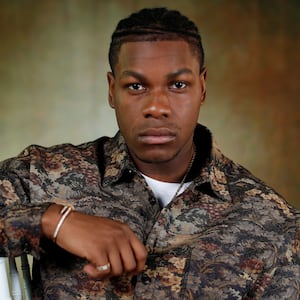Michael K. Williams’ path to becoming one of the most prolific television actors of the 21st century started with a Janet Jackson video. It’s a story he shared in interviews before his death on Sept. 6, 2021, from a drug overdose in his Brooklyn apartment and one he offers again in his engrossing posthumous memoir, Scenes from My Life, out today through Crown Publishing Group.
The anecdote goes that Williams was an uninspired 22-year-old living at home with his mother when Jackson’s iconic black-and-white visual for “Rhythm Nation” appeared on the MTV countdown “like a message beamed from the future,” he writes in an early chapter titled “Janet.” He describes the visceral connection he felt watching the scared little boy crying at the start of the video as an ominous elevator lowers in a factory where Jackson and her dancers eventually emerge with an empowering message. Just as the boy is drawn to Jackson’s alluring sound, Williams found himself gravitating toward a world of dance through his television screen, bringing him a sense of comfort about his identity as a young Black man from the projects that he hadn’t formerly experienced.
“The boy is no longer alone,” Williams writes reflexively. “He is far from healed—he will never fully be healed—but there’s a glint in his eye. The world has made room for him.”
Scenes from My Life: A Memoir, co-authored by Jon Sternfeld, is filled with fateful moments like these where Williams encounters larger-than-life figures and moving works of art that would have a profound impact on his life as a performer, activist, and struggling addict—for better or worse. Through equally compelling and devastating passages, The Wire star demonstrates the power of artistic expression to momentarily transport people from the toughest of circumstances. He also illustrates the extent to which art can save you from an unrelenting disease such as drug addiction.
Williams’ battle with substance abuse, specifically crack cocaine, is always lurking in the background. “I know it never comes around; you’re never free for good,” he writes about a successful night of not getting high. “Being an addict means forward and back constantly,” he explains in another chapter. “It means saying no again and again.”
The book serves as a potent reminder of the circular nature of recovery. Likewise, Williams doesn’t write about the state of his sobriety with much certainty, which makes it even more of a shattering read. Particularly because of his line of work and the intense roles he was offered, Williams was constantly revisiting the most traumatic parts of his adolescence and young adulthood, whether it was losing his family and friends to the criminal justice system, witnessing death and violence as a child in East Flatbush, his relationship with his abusive mother, or being sliced across his face outside a bar. Each project he was involved in, like HBO’s seminal The Wire, the prison-set miniseries The Night Of, and HBO Max’s Lovecraft Country got “closer to the white meat,” as he describes it, creating a rather thorny relationship with the thing he loved the most.
Of course, Williams was more than a man defined by his demons. He was a curious, open-minded individual from a young age, absorbing the creative surroundings he often randomly wound up in. Some of the most interesting parts of the book are when he writes about his days visiting the SoHo nightclub Garage with a lesbian friend named Robin, who was both a mentor and a negative influence. He fell in love with house music and lived out his desires to dance professionally every weekend until he was recruited as a background dancer for singer Kym Sims and would go on to support bigger names like Madonna and George Michael. This would lead to other opportunities in modeling, theater, and screen acting that mostly occurred by happenstance, a theme throughout his fascinating journey to becoming widely known as Omar Little on The Wire.
In the memoir, Williams doesn’t depict his rise to household-name status as particularly glamorous or meteoric. Much of the chapters focused on his career underscore the gap between being famous and being financially stable, a paradox that many Black people and minorities in the entertainment industry deal with. For instance, he’s open about misusing his paychecks from The Wire and being completely broke between seasons of the series due to his lack of experience with large sums of money. He would often find himself back in his mother’s apartment asking for loans. This would lead to feelings of insecurity that were compounded by his experiences living in poverty, but also the potential that he could fall back into drugs.
It seems Williams could never really escape the community that raised him—and he didn’t necessarily want to, despite the harsh memories he accumulated there. Inspired by his nephew Dominic, who was convicted of murder for an accidental shooting, he began educating himself about the criminal justice system and using his connections with then-President Barack Obama, an avid Omar fan, to advocate for the release of inmates serving unjust sentences. Additionally, he would give talks to children in Brooklyn public schools and visit prisons. And during the COVID-19 pandemic, he worked with NYC Together to launch a summer youth employment program, and We Build the Block to register voters. The end of the book presents Williams as a galvanized man approaching a more radical political consciousness.
Out of all the fascinating tidbits and insights readers may gain from Williams’ memoir, the most striking thing about the actor, to me, was how generous he was with his time, whether it was a fan wanting an autograph or a group of teens in a detention center needing words of encouragement.
Most celebrities do these things for the photo op, but for Williams, you get the impression that his generosity extended far beyond politeness. It was a deeper spiritual calling based on the suffering he dealt with his whole life and a form of temporary healing. Even if it wasn’t enough to heal himself, you’re consoled by the seeds he left behind.


